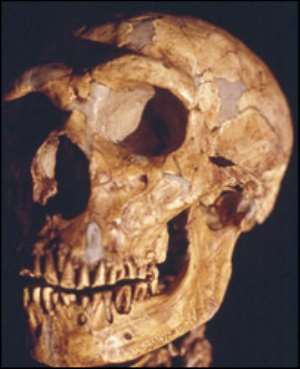
Scientists have recovered DNA from a Neanderthal that lived 100,000 years ago - the oldest human-type DNA so far.
It was extracted from the tooth of a Neanderthal child found in the Scladina cave in the Meuse Basin, Belgium.
The study, reported in Current Biology, suggests our distant cousins were more genetically diverse than once thought.
Their diversity had declined, perhaps because of climate change or disease, by the time early humans arrived in Europe about 35,000 years ago.
Past diversity
French and Belgian researchers isolated the genetic material from mitochondria. These are "power pack" structures in cells which contain their own DNA.
The scientists decoded the sequence of 123 DNA "letters" (base-pairs, or bp) and compared it with other known Neanderthal DNA sequences from specimens dated between 29,000 and 42,000 years old.
"The Scladina sequence has revealed that the genetic diversity of Neanderthals has been underestimated," a team led by Dr Catherine Hanni of Ecole Normale Superieur in Lyon, France, wrote in the journal Current Biology.
"Thus, more Neanderthal sequences than the six presently available and longer than 100 bp are needed to fully understand the extent of the past diversity of Neanderthals."
Disease threat
The findings suggest that genetic diversity was greater in earlier Neanderthal history than in later times, when humans started to arrive in Europe.
Such changes are thought to reflect fluctuations in the population, caused by disease or environmental change, as well as random genetic mutations over time.
"Diversity tells us about how old a population is and its demographic history," said Dr Robert Foley, an expert in human evolution at the University of Cambridge, UK.
Neanderthals lived between 230,000 and 28,000 years ago in Europe, Central Asia and the Middle East.
They were skilled hunters and well adapted to living during the ice ages; but they started to die out after modern humans (Cro-Magnons) appeared on the scene in Europe.
The reason for their sudden demise is unknown, but various theories have been proposed, including biological, environmental and cultural factors.
The DNA studies conducted so far suggest little, if any, interbreeding between Neanderthals and modern humans took place.




 Election 2024: Ghanaians will vote to erase Akufo-Addo’s horrifying legacy – Nii...
Election 2024: Ghanaians will vote to erase Akufo-Addo’s horrifying legacy – Nii...
 BP killed ex-Weija-Gbawe MCE – Tina Mensah reveals
BP killed ex-Weija-Gbawe MCE – Tina Mensah reveals
 Limited voter registration exercise: NDC slams EC over mass technical challenges
Limited voter registration exercise: NDC slams EC over mass technical challenges
 UK, America will one day come to Ghana to borrow Akufo-Addo to be their presiden...
UK, America will one day come to Ghana to borrow Akufo-Addo to be their presiden...
 EOCO returns fire at OSP over Cecilia Abena Dapaah’s money laundering case
EOCO returns fire at OSP over Cecilia Abena Dapaah’s money laundering case
 Anti-corruption endeavours must be rooted in systems, investigations and prosecu...
Anti-corruption endeavours must be rooted in systems, investigations and prosecu...
 We’ve not introduced 1% cybersecurity levy on banking transactions – BoG
We’ve not introduced 1% cybersecurity levy on banking transactions – BoG
 EU hits out at sidelining of Chad election observers
EU hits out at sidelining of Chad election observers
 ‘Be calm; we’re having engagements on new fee implementation’ — KNUST SRC assure...
‘Be calm; we’re having engagements on new fee implementation’ — KNUST SRC assure...
 Bawumia is compassionate, unique politician without corruption tag — Miracles Ab...
Bawumia is compassionate, unique politician without corruption tag — Miracles Ab...
